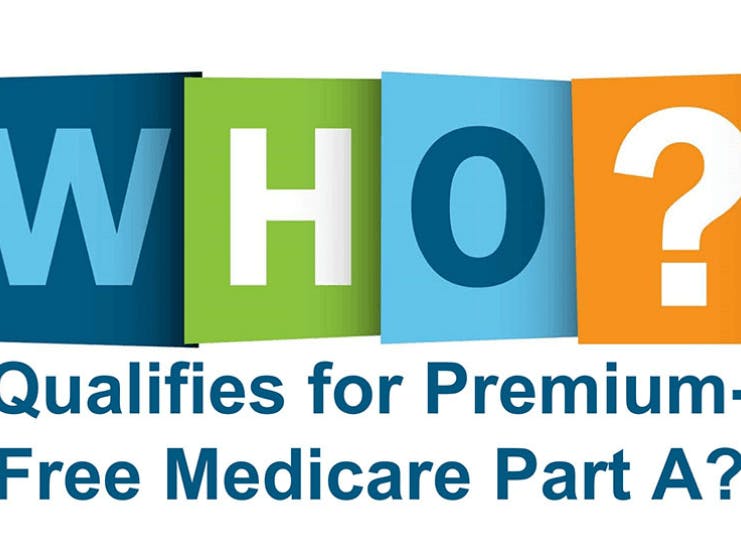
As long as you or your spouse paid the Medicare Tax for at least 10 years, you qualify for premium-free Part A.
When it comes to Original Medicare (Parts A and B), most people end up paying relatively little in monthly premiums. One of the main reasons for this is that Medicare Part A health insurance is offered to most beneficiaries with no premiums at all.
The way that this works can be a bit complex, and most people never have to deal with it: they automatically receive medical insurance and never pay a premium. However, understanding who qualifies for this premium-free version of Part A, as well as what exactly it entails, is essential if you’re going to be enrolling in Medicare soon.
We’ll run through the full set of details regarding how premium-free Part A works, including some misconceptions about what you will pay as well as exactly what you need to know to find out if you qualify.
What Is Part A?
Medicare Part A is often referred to as your hospital insurance. However, it’s more accurately described as inpatient insurance: it covers the health care you receive while you are an inpatient. This includes things like hospice care, skilled nursing facility care, and home care in some instances.
Part A is part of Original Medicare, which means that you may be enrolled in it automatically when you become eligible at age 65.
Who Is Eligible for Part A?
In order to receive premium-free Part A, you must of course be eligible for Part A generally. The eligibility for Part A is simple: if you are 65 or older, have been receiving disability benefits for 25 months or longer, and have ESRD (kidney failure requiring dialysis) or ALS (Amyotrophic Lateral Sclerosis, also known as Lou Gehrig's disease), then you are eligible to receive Medicare Part A insurance.
How Does Social Security Fit In?
When you read about Medicare enrollment, you will often see Social Security mentioned. The reason for this is that your Social Security benefits can work in tandem with your Part A and Part B coverage.
Basically, if you already receive Social Security or Railroad Retirement Board benefits, then you’ll be able to enroll automatically and have your monthly premiums if you have any, taken out of your benefits check automatically.
So, What Is Premium-Free Part A?
Although it’s sometimes referred to as free Part A, it’s important to note that the actual term is premium-free Part A. This is, as the name indicates, a form of the Part A health plan that has no monthly premium. This seems odd to some people, but yes, there is truly a $0 premium - you pay nothing each month.
However, remember that premium-free Part A isn’t really free. For one, you will still have to pay out-of-pocket costs including your coinsurance, deductible, and copay under Part A.
And, you’re only eligible for premium-free Part A if you’ve paid a certain tax for a certain amount of time. In essence, you pay for premium-free Part A through your taxes for years, and then don’t pay any additional taxes when the time comes for your coverage to begin.
How Do You Qualify for Premium-Free Part A?
As we mentioned above, the first step to qualifying for premium-free Part A is to qualify for Part A normally. The additional qualifications for premium-free Part A mostly have to do with how long you have paid the Medicare Tax for. To reiterate the full eligibility guidelines, you will be eligible for premium-free Part A if:
- You receive retirement benefits from Social Security or the Railroad Retirement Board
- You are eligible to receive these benefits but haven’t received them yet
- You or your spouse had Medicare-covered employment
If you are under 65:
- You’ve received retirement benefits for over 24 months
- You have ESRD
In all of these cases, the key additional qualification paying the Medicare Tax for 40 Quarters or longer.
You will also be eligible for premium-free Part A if your spouse has paid the Medicare Tax for this period of time. However, the time can’t add up. So, if you’ve paid the Medicare Tax for 20 quarters and your spouse has also paid it for 20 quarters, neither will be eligible for premium-free Part A.
Part A with Reduced Premiums
In addition to premium-free Part A, there is also a way to get Part A with reduced premiums. For premium-free Part A, you must have paid the Medicare Tax for 40 quarters or longer. If you or your spouse have paid the Medicare Tax for 30-39 quarters, you'll pay $278 per month.
If you’ve paid the Medicare Tax for under 30 quarters, the monthly premium is $506.
How Does This Relate to Other Parts of Medicare?
In addition to Part A, there are of course other parts of Medicare. Medicare Part B, Part C (Medicare Advantage), and Medicare Part D are not available in a premium-free version in the same way.
When it comes to Part B and Part D prescription drug coverage, you will always pay a monthly premium. Medicare Advantage plans can offer Medicare coverage with no premiums, but these plans will have very high out-of-pocket costs and aren't a good fit for most beneficiaries.
Should I Enroll in Part A Only?
Because Part A offers a unique way to receive your benefits without paying premiums, it can sometimes seem like a good idea to only enroll in Part A. However, this won't be a good idea for most people.
If you choose to enroll in Part A but not Part B, and you aren't under a group plan, then you may experience a gap in coverage or face a Part B late enrollment penalty. This can end up costing even more than enrolling in Part B from the outset.
If you have a group health plan from your employer, you will be able to defer Part B but enroll in Part A and not face a late penalty. When you no longer have your employer-based plan, you will trigger a Special Enrollment Plan and be able to enroll in Part B without paying a late fee.
Medicare and HSAs
As a rule, you cannot contribute to an HSA, or health savings account, while you are enrolled in Medicare. As such, this should contribute to any discussion you have about whether or not to defer your coverage to a later time.
Although you can't contribute to an HSA while you are covered by Part A, there is a Medicare option known as a Medicare Savings Program. While these programs aren't exactly the same as health savings accounts, they will offer some of the same types of benefits if you prefer this coverage style.
What About Medigap?
Medigap plans, also known as Medicare Supplement plans, are private insurance plans that can help pay for out-of-pocket costs associated with your Medicare benefits. Although these plans cover things like your coinsurance and copay, they won't actually cover your monthly premiums for any part of Medicare.
Late Enrollment Penalties
If you don't enroll in Medicare Part A during the Initial Enrollment Period around your 65th birthday and don't have a sufficiently good reason, you may need to pay a late enrollment penalty. Your monthly premium will go up by 10% for twice the number of years that you could have enrolled but delayed.
If you are eligible for premium-free Part A, your best bet is to just enroll as soon as you are eligible, since it will cost nothing each month.
Final Thoughts on Premium-Free Part A
As you can see, premium-free Part A is fairly simple. For most people, it will simply be automatic, and you won't have to deal with anything directly. The main things to remember are that if you don't receive premium-free Part A, you should be conscious of the late enrollment penalty. Additionally, remember that premium-free Part A isn't really free: it just has no monthly premium.



